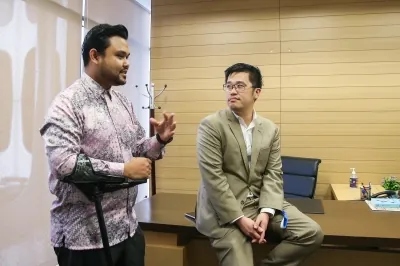
Living with Haemophilia: The Untold Daily Struggles of Malaysian Patients Fighting for Awareness
2024-11-03
Author: Mei
Introduction
Haemophilia, a rare bleeding disorder that affects less than 0.01% of the population in Malaysia, presents numerous challenges for patients who require daily medical care and constant vigilance to avoid serious complications. This often invisible illness not only impacts their physical health but also subjects them to societal stigma and significant misunderstanding.
Shakir Aziz's Journey
One such brave individual navigating these choppy waters is Shakir Aziz, the vice-president of the Hemophilia Society of Malaysia. Shakir's journey illustrates the real struggles faced by patients who endure both physical hardships and societal misconceptions. "Growing up, I was always reminded to be careful. It often felt as though I lived in a bubble, and I yearned for normalcy," he shared in a recent interview, where he recounted a childhood incident that triggered a severe intracranial bleed—an experience that deepened his understanding of the need for caution.
Statistics and Challenges
Around 1,400 individuals in Malaysia are affected by haemophilia, a condition where blood clotting is impaired, leading to prolonged bleeding when injuries occur. Severe bleeding can also occur internally, particularly affecting the joints and causing chronic pain, which can contribute to early mobility issues and a reduced quality of life. The emotional toll of such an ailment is further compounded by a pervasive lack of public awareness and the fear of judgment from others.
Advocacy for Awareness
Understanding and increasing awareness of invisible conditions such as haemophilia is crucial. Shakir and other advocates are urging the government and public to comprehend that they are not seeking special treatment but simply acknowledgment of their condition. There are ongoing efforts involving lawmakers like Ipoh Timur MP Howard Lee Chuan How to initiate public service campaigns that educate the community about haemophilia and other rare diseases. "We want a catchy campaign, something similar to the impactful ads of the past," he remarked, highlighting the power of effective communication.
Advancements in Treatment
In addition to awareness, advancements in treatment options are fostering hope among patients. Preventive treatment is essential to maintaining stable clotting levels, and traditional methods typically involve frequent intravenous injections of clotting factors. However, innovative alternatives now present subcutaneous injections that last for up to three weeks, offering a more convenient and less painful option, particularly for children. Yet, challenges remain; some patients develop resistance to standard treatments, necessitating expensive alternatives that can lead to frequent hospital visits and added stress for families.
The Power of Community
Despite the systemic barriers, Shakir finds a silver lining within the haemophilia community. "Our support network is invaluable. It provides a space where we can share our stories and learn from one another," he noted. Together, they strive to live fulfilling lives while managing their condition. Shakir emphasized that haemophilia does not define an individual; instead, it is one aspect of their life. "With the right support, we can thrive and contribute to society. It's essential to foster understanding rather than pity."
Encouraging Sharing of Experiences
To promote a more inclusive society, he encourages his fellow haemophiliacs to openly share their experiences. "Awareness leads to understanding, which is fundamental in addressing the complexities of living with this disorder," Shakir expressed.
Conclusion
Despite the daily challenges, those living with haemophilia like Shakir continue to forge ahead, proving that resilience and awareness can lead to a brighter future for all affected by this invisible struggle.




 Brasil (PT)
Brasil (PT)
 Canada (EN)
Canada (EN)
 Chile (ES)
Chile (ES)
 España (ES)
España (ES)
 France (FR)
France (FR)
 Hong Kong (EN)
Hong Kong (EN)
 Italia (IT)
Italia (IT)
 日本 (JA)
日本 (JA)
 Magyarország (HU)
Magyarország (HU)
 Norge (NO)
Norge (NO)
 Polska (PL)
Polska (PL)
 Schweiz (DE)
Schweiz (DE)
 Singapore (EN)
Singapore (EN)
 Sverige (SV)
Sverige (SV)
 Suomi (FI)
Suomi (FI)
 Türkiye (TR)
Türkiye (TR)